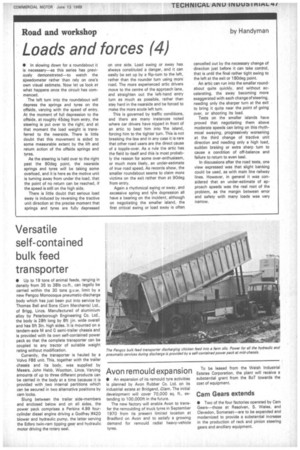Road and workshop
Page 49

If you've noticed an error in this article please click here to report it so we can fix it.
Loads and forces (4)
• In slowing down for a roundabout it is necessary—as this series has previously demonstrated—to watch the speedometer rather than rely on one's own visual estimate. Now let us look at what happens once the circuit has cornmen ced.
The left turn into the roundabout will depress the springs and tyres on the offside, varying with the speed of entry. At the moment of full depression to the offside, at roughly 45deg from entry, the steering is put over to the right, and at that moment the load weight is transferred to the nearside. There is little doubt that this movement is aided to some measurable extent by the lift and return action of the offside springs and tyres.
As the steering is held over to the right past the 90deg point, the nearside springs and tyres will be taking some overload, and it is here as the motive unit is turning away from under the load, that the point of no return can be reached, if the speed is still on the high side.
There is little doubt that serious load sway is induced by reversing the tractive unit direction at the precise moment that springs and tyres are fully depressed on one side. Load swing or sway has always constituted a danger, and it can easily be set up by a flip-turn to the left, rather than the rounder turn using more road. The more experienced artic drivers move to the centre of the approach lane, and straighten out the left-hand entry turn as much as possible, rather than stay hard in the nearside and be forced to make the more acute left turn.
This is governed by traffic conditions, and there are many instances noted where car drivers have nipped in front of an artic to beat him into The island, forcing him to the tighter turn. This is not breaking the law and in any case it is rare that other road users are the direct cause of a topple-over. As a rule the artic has the field to itself and this is most probably the reason for some over-enthusiasm, or much more likely, an under-estimate of true road speed. As records show, the smaller roundabout seems to claim more victims on the exit rather than at 90deg from entry.
Again a rhythmical swing or sway, and excessive spring and tYre depression all have a bearing on the incident, although on negotiating the smaller island, the first critical swing or load sway is often cancelled out by the necessary change of direction just before it can take control, that is until the final rather tight swing to the left at the exit or 180deg point.
An artic can run into the smaller roundabout quite quickly, and without accelerating, the sway becoming more exaggerated with each change of steering, needing only the sharper turn at the exit to bring it quite near the point of going over, or shooting its load.
Tests on the smaller islands have proved that negotiating them above moderate speeds can bring on this rhythmical swaying, progressively worsening at the third change of tractive unit direction and needing only a high load, sudden braking or extra sharp turn to cause a condition of off-balance and failure to return to even keel.
In discussions after the road tests, one view expressed was that slight banking could be used, as with main line railway lines. However, in general it was considered that an under-estimate of approach speeds was the real root of the problem, as the margin between error and safety with many loads was very narrow,
























































































































































